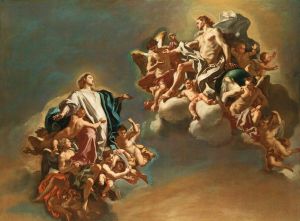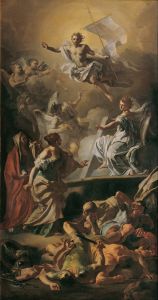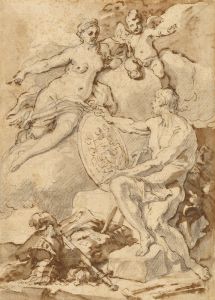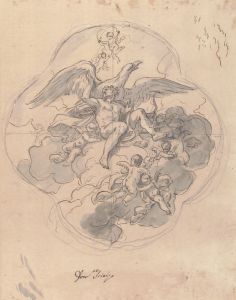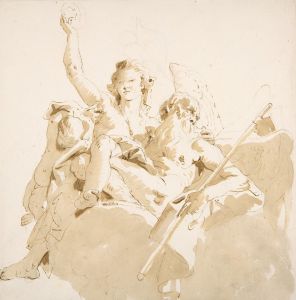
Minerva With Chronos And History; A Study For An Allegory Of The Reign Of The Hapsburgs In Naples
A hand-painted replica of Francesco Solimena’s masterpiece Minerva With Chronos And History; A Study For An Allegory Of The Reign Of The Hapsburgs In Naples, meticulously crafted by professional artists to capture the true essence of the original. Each piece is created with museum-quality canvas and rare mineral pigments, carefully painted by experienced artists with delicate brushstrokes and rich, layered colors to perfectly recreate the texture of the original artwork. Unlike machine-printed reproductions, this hand-painted version brings the painting to life, infused with the artist’s emotions and skill in every stroke. Whether for personal collection or home decoration, it instantly elevates the artistic atmosphere of any space.
Francesco Solimena, an influential Italian Baroque painter, created the artwork "Minerva With Chronos And History; A Study For An Allegory Of The Reign Of The Hapsburgs In Naples." Solimena was born in 1657 in Canale di Serino, near Avellino, and became one of the leading figures in the Neapolitan Baroque movement. His works are known for their dramatic intensity, vibrant color palette, and intricate compositions, which reflect the grandeur and dynamism typical of Baroque art.
This particular painting is a study for an allegorical piece that represents the reign of the Hapsburgs in Naples, a period marked by significant political and cultural developments. The Hapsburgs, a powerful European dynasty, ruled Naples from 1504 to 1707, and their influence extended into various aspects of Neapolitan life, including art and architecture. Solimena's work often engaged with themes of power and divine right, making him a fitting artist to explore such a subject.
In "Minerva With Chronos And History," Solimena employs classical mythology to convey the themes of wisdom, time, and historical narrative. Minerva, the Roman goddess of wisdom and strategic warfare, is often depicted as a symbol of enlightened rule and intellectual prowess. Her presence in the painting suggests the wisdom and guidance that the Hapsburgs purportedly brought to Naples. Chronos, the personification of time, underscores the enduring nature of their reign and the historical significance of their governance. The inclusion of History as a figure in the painting highlights the importance of recording and interpreting the past, a task that was particularly relevant during the Hapsburg era as they sought to legitimize their rule through historical narratives.
Solimena's composition likely features these allegorical figures interacting in a dynamic and harmonious manner, reflecting the interconnectedness of wisdom, time, and history. The use of rich colors and dramatic lighting would be characteristic of Solimena's style, enhancing the allegorical message and engaging the viewer in a visual dialogue about the nature of power and legacy.
The painting serves not only as a celebration of the Hapsburgs' rule but also as a testament to the broader cultural and artistic currents of the time. Solimena's work is a prime example of how art was used as a tool for political expression and propaganda, illustrating the complex relationship between artists and their patrons.
While specific details about the painting's current location or provenance might not be readily available, Solimena's legacy as a master of Baroque art remains undisputed. His ability to weave together mythological and historical themes into a cohesive and visually compelling narrative continues to be admired by art historians and enthusiasts alike. Through works like "Minerva With Chronos And History," Solimena has left an indelible mark on the artistic landscape of his time, offering insights into the cultural and political milieu of 17th-century Naples.






